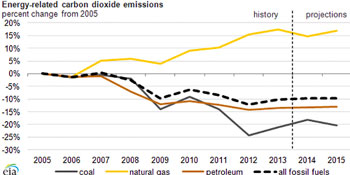While greenhouse gas emissions rose 1.9% last year in the US, they fell 6% in the Northeast, where nine states participate in the very successful cap-and-trade program, the Regional Greenhouse Gas Initiative (RGGI).
For the US figures, the data relates to energy-related emissions, produced by the US Energy Information Administration (EIA); RGGI data is for power sector emissions.
Carbon emissions in RGGI states dropped for the third consecutive year as electricity use declined in four states – thanks at least partially to efficiency efforts – and renewable energy rose. A coal plant closed and use of natural gas increased.
Energy-related emissions rose in 2013 for the US as a whole because coal made a bit of a come-back due to rising natural gas prices. The average wholesale price for natural gas rose 35% last year. This is the first time US emissions rose in five years and is also a sign that the economy is recovering.
US emissions remain about 10% below 2005 levels, still on track (but it will be harder) to meet President Obama’s goal of 17% below those levels by 2020. Regulating power plant emissions will be essential to reaching the goal.
EIA expects US emissions to rise again in 2014 by 1.2% – as coal use continues in response to higher natural gas prices. In the following year, however, the emissions should trend down again as coal plants close.

Continuing to rely on coal is holding the economy back, says the Union of Concerned Scientists, because 37 states pay to import coal from the few states that produce it – mostly Wyoming, Kentucky and West Virginia. Importing states pay dearly for that – a total of $19.4 billion in 2012, with eight spending over $1 billion.
"This money can be better spent on investments in homegrown clean energy sources, which keep more money in these states," says Jeff Deyette at Union of Concerned Scientists.
Texas imports the most coal, spending $1.85 billion in 2012, followed by North Carolina, Georgia, Missouri, Florida, Michigan, South Carolina, Alabama, Tennessee and Wisconsin.
Even with these huge expenditures, that’s 25% lower than before 2008 as utilities bought more natural gas.
More details are here:
